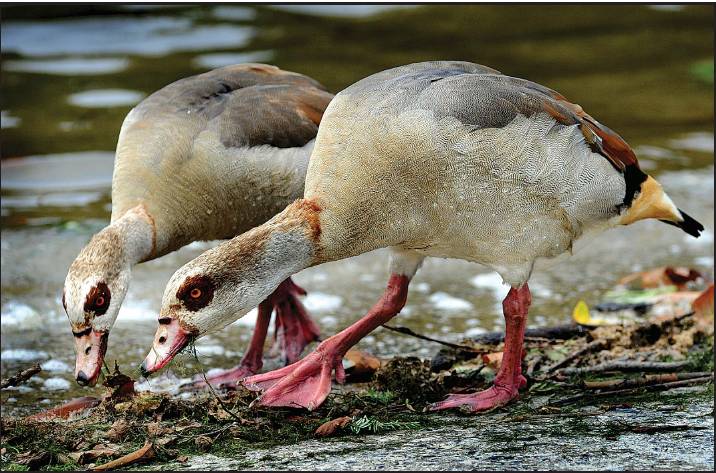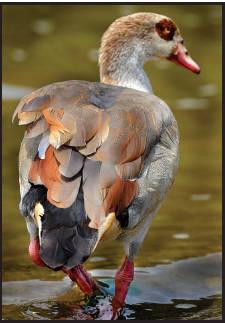Egyptian Geese Visit
Waterfowl make home at Cheat Lake marina
Morgantown Dominion Post
26 July 2012

A pair of Egyptian geese (alopochen
aegyptiacus) have taken up residence at the Sunset Beach Marina
on Cheat Lake. The distinctive chocolate-colored eyepatch makes
them stand out from the other, more common waterfowl of the
area. Bob Gay/The
Dominion Post
Two waterfowl at Sunset Beach Marina are turning heads. They are a
pair of Egyptian geese, colorful birds that aren’t native to West
Virginia.
“They have been here since I started working in April,” said Ben
Ray, an employee at Sunset Beach Marina.
“If I toss them some Fritos, they will hang around all day,” Ray
said. “The bigger one, the male, gets pretty feisty if you get too
close.”
Morgantown resident Susan Robison said her brother, Kevin
Humphreys, a former zoo keeper in Norfolk, Va., identified the
species as Egyptian geese after they saw them at the marina.

The colorful plumage of the Egyptian
geese contains a wide mix of brown and gray tones. Bob
Gay/The Dominion Post
“My brother said they mate for life. The strange part of all of
this is, where did they come from? The Egyptian goose is a member
of the duck, goose and swan family Anatidae. It is native to
Africa, south of the Sahara and the Nile Valley, and has been
introduced to parts of Western Europe — not Morgantown, W.Va.”
Susan Olcott, District 1 diversity biologist with the state
Division of Natural Resources, said many people keep exotic
waterfowl as curiosities. People sometimes put the birds on their
ponds, snipping their feathers to keep them from flying away.
But, if the snipping isn’t done properly, the feathers will regrow
and the birds can fly again, Olcott said. Someone may also have
tired of them and set them free, she speculated.
She was unsure if the birds would be able to survive a West
Virginia winter but said Cheat Lake would be a good place for
them, because people will likely feed them.
If they do, it might bring luck. According to Robison, “Upon doing
some additional research, I also found Egyptian geese were
considered sacred by the ancient Egyptians, and appeared in much
of their artwork.”

